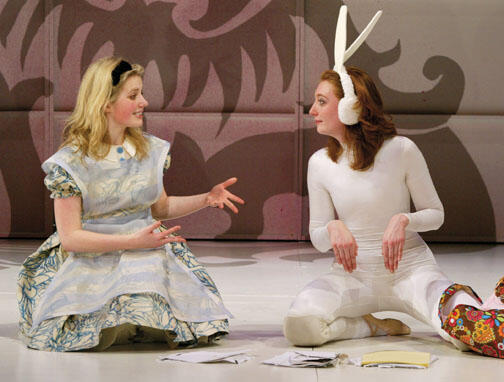On the Campus
What if Alice, of Alice in Wonderland andThrough the Looking-Glass, were 21 instead of 12 and attended Princeton? The meeting with the Red Queen would become a Career Services appointment; Humpty Dumpty, a professor enthralled by close reading and the sexual overtones of the Jabberwocky; and the White Queen, a fellow student consumed by stress.
Veronica Siverd ’10’s thesis production ofAlice in Wonderland, titled “Alice: A New Play,” is a Victorian coming-of-age story for the 21st century. Siverd’s original play, which was staged in early March in the Berlind Theater, expands on Lewis Carroll’s magical world. “The play is about being caught between childhood and adulthood,” Siverd explained. “That didn’t happen for me at the age of 12. I was quite a happy 12-year-old. Instead, all that anxiety is happening to me now.”
Like Alice herself, Siverd’s relationship with Carroll’s story has grown, shrunk, and grown again over the years. Humpty Dumpty was Siverd’s favored stuffed toy; Siverd celebrated her sixth birthday with an Alice in Wonderland-themed party, and in high school she and a friend were known to re-enact the caterpillar scene.
Siverd’s adaptation, a combined thesis in theater and the English department, remains fantastical, with an ensemble of four women, an array of puppets, and a brightly hued checkerboard stage. All the familiar characters are there, but every scene is infused with the concerns of a girl about to graduate from college. “Who are you?” the caterpillar insistently presses, and Alice/Siverd is flummoxed by the existential nature of the question. The White Rabbit who hops across the stage in a leotard and fluffy bunny ears becomes Siverd’s mother, caught between wanting to protect her daughter and allowing her to grow up. On stage, Siverd admits, there are times she forgets she is acting.
Siverd is positive she won’t put the play away after its last performance, “but I also want to respect the fact that it’s about what I’ve been feeling this year, this semester.” Perhaps Siverd will write new versions of Alice — reflecting herself in five years or 10. “Wonderland is such a lovely filter. Everyone should write their own Wonderland!”
By Ben Fong GS
The Bernstein Gallery of Robertson Hall, which hosts the Woodrow Wilson School’s art exhibits, seeks to show “provocative work that sparks discussion and debate,” according to Dean Christina Paxson.
The latest exhibition, titled “As the World Turns Then and Now,” is a series of mixed-media photo montages by artist Rhonda Wall that show often-violent portrayals of the Middle East. Images of armed militants are juxtaposed with symbols of Arab culture.
While many students agreed that the exhibit is meant to be jarring and provocative, some raised questions about pieces with titles like “Suicide Bombers, Spiderman, and Saddam,” a collage in which images of suicide bombers are paired with Islamic symbols and Arabic lettering. Morgan Courtney GS said that while there is a place for such works of art, the political message is unclear and there is “not enough explanation of intent.”
Jess Morse GS said that the images “perpetuate stereotypes of a war-mongering U.S.,” while members of the Arab Society charged that the exhibit reinforces stereotypes of Arabs and Muslims as violent extremists.
Paxson, gallery curator Kate Somers, and Professor Stanley Katz, the faculty gallery director, met with students to discuss their concerns. In response, the dean said, students will be added to the committee that selects gallery exhibitions. In addition, Somers said, “more careful and explicit contextualization of our shows” will be offered. The goal, said Paxson, is “to reduce the chance that the exhibits offend members of our community.”
Somers said in an e-mail that the current exhibition, which is on display through April 8, “brilliantly captured a visceral sense” of the period following the 9/11 terrorist attacks while being “part of a lineage of artists (Goya, Magritte, Picasso) who have expressed their outrage at war by giving us images of violence and cruelty.”
Paxson said she believed that the artist, “while condemning extremist violence of all types, was also holding up these very stereotypes for criticism.” But the reaction to the exhibit, Paxson added, was a lesson in how different people can have very different responses to the same piece of artwork.













No responses yet